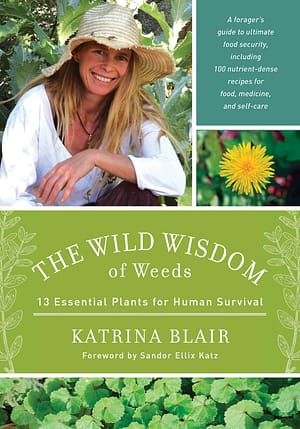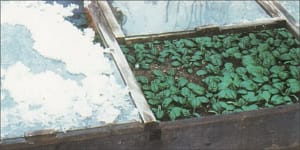Abundant Kudzu: Uncovering the Many Uses

Tao Orion, author of Beyond the War on Invasive Species, and Katrina Blair, author of The Wild Wisdom of Weeds, share alternative approaches to understanding and managing Kudzu.
Classification: Pueraria lobata
Geographic location: Southeast
Description: Kudzu is a group of plants that are climbing, coiling, and trailing perennial vines. The plant climbs over trees or shrubs and grows very rapidly. Each leaflet is large and ovate with two to three lobes each and hair on the underside.
Could Kudzu be Used in Place of Alfalfa?
By Tao Orion
Kudzu is a long-lived perennial nitrogen fixing plant. Pollinators of all kinds love its prodigious lavender blooms, which yield a deep purple honey. It is edible and medicinal for both people and other animals.
It can grow up to one foot per day, its vines stretching to over forty feet in length in a single growing season.
Kudzu is now considered an invasive species in the southeastern US, though the Soil Conservation Service once paid farmers in the area to plant it to stabilize erosion-prone slopes and add fertility to depleted soils.
When it comes to management, kudzu’s rapid vegetative growth can seem daunting, but consider what that growth represents in the context of another important perennial legume – alfalfa.
Anyone that keeps dairy animals knows how necessary – and how precious – alfalfa is to keeping their animals satiated and their milk production consistent, especially if you’re feeding little or no grains.
In contrast to kudzu’s prolific and seemingly unstoppable growth, alfalfa production (at least in the conventional context) requires significant inputs of water to keep it producing in the hot, dry desert ecosystems where it thrives.
Farmers in California’s Imperial Valley grow nearly 2 million pounds of alfalfa every year, irrigated by water piped in at enormous ecological and economic cost from the Colorado River.
Farmers in Oregon’s Klamath Basin produced nearly twice that amount, on what was once one of the world’s largest wetlands and a critical stopover point for birds migrating along the Pacific Flyway.
And, since the 2011 Supreme Court ruling that allowed the distribution of Round-Up Ready alfalfa, an estimated 60-90% of conventional alfalfa farmers in the US have transitioned to this seed/chemical technology in the hopes of boosting production.
Meanwhile, two thousand miles away in Georgia, land managers spray Round Up on kudzu in the attempt to keep its prolific growth – which requires no supplemental irrigation or pesticides of any kind – in check.

In the southeastern US, the prolific growth of kudzu could represent the beginnings of a thriving small-scale grain-free dairy industry in the region, with smallholders carefully managing land covered in kudzu to raise healthy animals free from outside protein inputs.
With careful management, the land could either continue to produce kudzu in perpetuity, or could be transitioned to other plants or crops that would thrive in the soil enriched by both manure and the nitrogen-rich soil left behind by the kudzu.
Using Kudzu to Make Land More Fertile
By Katrina Blair
Back in the 1800’s Kudzu was marketed in this country as an ornamental to shade porches, and utilized as a high protein fodder for cattle as well as a cover crop to prevent soil erosion.
In the 1930s and 40s the U.S. government subsidized farmers to plant an estimated 3 million acres of kudzu to help combat soil erosion from poor farming practices.
Yet, in the 1990s it was placed on the Federal Noxious Weed List.
What happened? Why is this former wonder-plant suddenly a problem? Is there a problem? Is the problem kudzu, or is the problem that we are spraying toxic herbicides on a valuable plant? Are we overlooking the great uses and benefits of what kudzu has to offer humanity?
It is time to focus on moving forward from where we are and research all the amazing uses of this excessive resource. Kudzu is a high protein food not only for animals but for humans too.
The leaves, young shoots, roots, flowers, and vine tips are all edible either raw or cooked. In addition, it is an amazing mulch–it gives nitrogen back to the soil and increases the fertility of the lands.
What non-renewable resource can kudzu replace?
Can it help us create energy for powering our civilization? Can it reduce the amount of food we import from other countries? Can it still provide a source of fodder for livestock? Can it replace GMO corn for this use?
Can it provide nutrients for deficiencies in our youth resulting from an excessive diet of highly processed foods? “Yes” is the answer to all these questions.
Together with good intentions and collaborative creativity we can partner with this plant and others to make a difference. We start by placing one foot in front of the other, gaining the momentum to improve quality of life for all beings.
Recommended Reads
Recent Articles
What’s so great about oyster mushrooms? First, you can add them to the list of foods that can be grown indoors! They are tasty, easy to grow, multiply fast, and they love a variety of substrates, making oyster mushrooms the premium choice. The following is an excerpt from Fresh Food from Small Spaces by R. J.…
Read MoreEver heard the phrase, “always follow your nose?” As it turns out, this is a good rule of thumb when it comes to chicken manure. Composting chicken manure in deep litter helps build better chicken health, reduce labor, and retain most of the nutrients for your garden. The following is an excerpt from The Small-Scale Poultry…
Read MoreIn her book, The Art of Science and Grazing, nationally known grazing consultant Sarah Flack identifies the key principles and practices necessary for farmers to design, and manage, successful grazing systems. This book is an essential guide for ruminant farmers who want to crate grazing systems that meet the needs of their livestock, pasture plants,…
Read MoreThis long-lived perennial legume is used for forage and erosion control. Kudzu is edible with many medicinal uses and other applications. Pollinators of all kinds love its prodigious lavender blooms!
Read MoreAre you ready to get a jump-start on the gardening season? With a cold frame, you can get started now. A cold frame harnesses the sun’s heat before it’s warm enough to let unprotected seedlings growing outside. Essentially, it consists of a garden bed surrounded by an angled frame and covered with a pane of…
Read More








